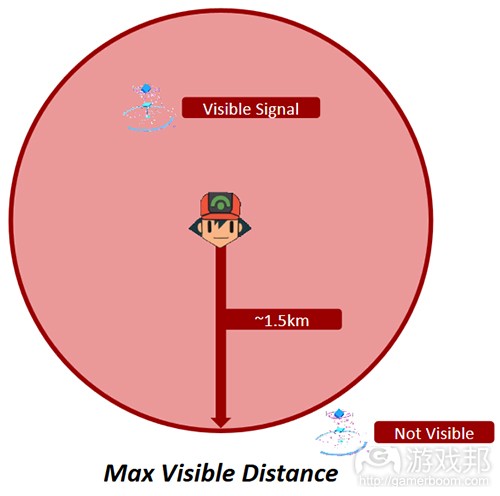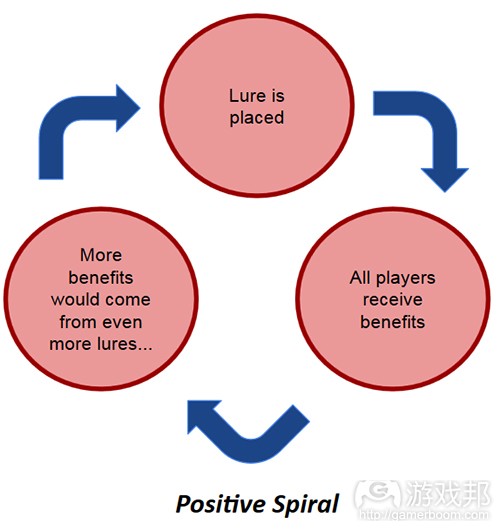《Pokemon Go》中创造出系统性群组的五大组件
作者:Brice Morrison
《当Pokemon Go》发行的第一个周末,我前往了市中心去寻找一些热点。并惊讶地发现在同一个场所聚集了超过40个人,他们都在玩《Pokemon Go》。虽然彼此互不相识,但却因为lures吸引了许多Pokemon而把我们聚集在了那里。
如果你也在玩这款游戏你便会清楚这些群众都很喜欢各种有趣的惊喜。突然出现在一群和你做着同样的事的陌生人中间是一件非常有趣的事。最终你都会参与到谈话,分享技巧与交朋友的过程中。而当lure结束时所有人也就会自然地散去。这真的是一种与众不同的游戏体验。
当全新技术出现时,全新游戏系统也会随之出现并为未来的游戏创造先例。就像当《塞尔达传说》作为第一款带着电池组的任天堂墨盒游戏出现时,它便围绕着全新的保存文件理念而创造了全新标准。当2009年Zynga的《FarmVille》问世时,社交网站上便充斥着许多想要获得锤子和钉子去创建自己的道具的请求,而这一设计也快速贯穿于无数游戏中。
所以《Pokemon Go》也毫无例外。作为一款最成功的GPS游戏,这款游戏的全新系统设计将推动其它游戏未曾尝试过的全新行为的发展。
而关于这些系统最有趣的一点便是创造系统性群组的游戏能力。这是源自鼓励两个或以上的玩家同时聚集在一个现实生活场所的游戏设计。
所以这种系统性群组是如何运行的呢?是什么在推动这种行为?同样的系统又会如何被用于未来的其它游戏中?
第一个组件:场所
作为《Pokemon Go》中的一种模式的系统性群组主要是由五大组件所组成:场所,信号,利益,持续时间以及正反馈循环。
《Pokemon Go》使用了lure系统而创造出了系统性群组。玩家可以在Pokestop使用一个lure去吸引更多pokemon。而其他玩家可以在他们的游戏中看到这个,然后他们便会选择前往现实生活中的这一场所去享用这一好处。
而首先这些群组最需要的便是一个能够将他们聚合在一起的特殊地理定位,场所不需要太大以便他们进行面对面的交流。《Pokemon Go》使用Pokestops作为地图上的固定点而做到了这点。lure将占据直径不到50米的优先区域,这意味着为了分享利益玩家必须在现实中尽可能地离这一区域较近。
第二个组件:信号
随着场所的选定,游戏设计便需要告知玩家一些特殊的事件正在上演。在这里信号就如灯塔一样将告诉玩家他们需要前往哪里。如果玩家不能从远处看到信号,他们便不可能聚集在一起。
在《Pokemon Go》中,所有玩家都可以通过Pokestops的粉色碎花看到lures。这将把他们引向一个特殊场所并将其有目的性地聚集在一起。
信号也将伴随着一个重要的协调值:最大能见距离,即超过这一距离玩家便看不到信号了。在《Pokemon Go》中,玩家可以在1.5公里以外看到Pokestops和lures。这一数值必须与其它协调值相互影响。
第三个组件:利益
场所需要传达许多玩家都想获得的利益。重要的是这一利益是所有在适当时间来到某一场所的所有玩家都可以共享的利益。
传统的MMO在这方面就不是如此:通常情况下只有一个玩家可以从一次战利品掉落中获得道具。虽然这样的设计适合MMO游戏,但它却不利于系统性群组。因为当人群聚集在一起时他们可以找到足够他们需要的内容。
在《Pokemon Go》中,这种利益便是在lure附近出现大量pokemon,甚至远远多于一般显示出来的数量。通过前往这一场所,玩家将可以捕抓到同样的pokemon,当然也有一些非常稀有的pokemon。
第四个组件:持续时间
系统性群组还需要适宜的持续时间。关于这一协调值存在两个界限。
首先持续时间不该太长从而让玩家会觉得必须马上前往特定场所。如果lures的持续时间为24小时,玩家看到lure后便会想:“那里有个lure,我将在几个小时后前往那里。”结果便是人们会分散地前往该场所而有可能不能见到面。而像30分钟这种相对较短的时间则会让玩家有:“哇,我必须现在就前往那里”的想法。
其次,持续时间也不能太短,从而让玩家拥有足够的时间能够前往指定场所去获取利益。《Pokemon Go》中玩家最远可以在1.5公里的位置看到lures。如果将其等价于30分钟时间,那么平均步行速度便需要是5公里/小时,如此玩家便拥有足够时间前往自己看到的lure并拥有12分钟的时间去捕抓pokemon了。
如果持续时间为15分钟,玩家便不可能走一英里的路到达那里。玩家经常会看到一些难以触及的lures。
基于这一原因,游戏必须有效平衡最远可见距离和持续时间这两个元素。
第五个组件:正反馈循环
最后,如果拥有正反馈循环,系统性群组设定将变得更有效,即意味着每个到达的玩家都能够为自己和别人提高利益范围。从理论上来看一个人便可以贡献一切,但这对于大多数玩家来说代价都太高了。相反地,大多数玩家都将受到推动去为自己创造利益,而这反过来也将提高呈献给其他所有玩家的利益并因此将累积每个玩家所创造的贡献。
在《Pokemon Go》中,一个lure是不可能吸引许多pokemon的关注。但如果在同一个场所出现3个,4个,5个或更多lures,那便能够吸引大量pokemon的注意,从而吸引更多玩家聚集于此。这种累积效应将鼓励玩家在到达这样的场所后会主动去添加自己的lures。
如果lure被启动并且玩家刚好经过,他们便会受到激励去添加自己的lure。其他玩家也会如此去添加lure,以此类推。这便是正反馈循环,即随着越来越多lure的出现将提升更多人添加lure的几率,也就会因此累积更多利益。
不过需要注意的是我并不认为强大的系统性群组设计需要一个正反馈循环。你也可以只让一个资深玩家去创造一个足以吸引更多玩家的活动(游戏邦注:这种情况有时候也会出现在《Pokemon Go》中)。但是正反馈循环却有助于吸引更多群组的注意。
这就像是一次聚会!
当你着眼于这五大组件时你会发现系统性群组与在现实生活中举办聚会一样。唯一的区别则在于比起人类举办者,在这里游戏本身才是真正的推动力量。
通过确保所有这五大组件的有效运行,任何游戏都有可能从这种愉悦群组的效应中获益。
(本文为游戏邦/gamerboom.com编译,拒绝任何不保留版权的转发,如需转载请联系:游戏邦)
How Pokemon GO’s Design Creates Systemic Crowds
by Brice Morrison
The first weekend Pokemon Go was released, I headed downtown to play and find some hot spots. I was amazed to meet over 40 people (pictured) at the same location, all playing Pokemon Go. None of the people in this photo know one another, but we were all there because of the lures attracting lots of pokemon.
If you’ve played the game you know that finding these crowds are smile-inducing surprises. It’s fun to suddenly be among a crowd of strangers who are all doing the same activity you are doing. You inevitably end up talking, swapping tips, and making friends. When the lures are up everyone disperses. It is a truly unusual and unique gaming experience.
Whenever there is technological advancement, new gameplay systems appear that create precedents for future games. When The Legend Of Zelda shipped as the first Nintendo cartridge with a battery pack, it created new standards around the idea of Save Files. When Zynga’s FarmVille took off in 2009, social networks were flooded with requests for hammers and nails to build their items, a design now standardized across hundreds of games.
Pokemon Go is no different. As the most successful GPS-enabled game ever made, new system designs are driving new types of behavior that no other game has been capable of.
One of the most interesting of these systems is the game’s ability to create systemic crowds. These come from a game design that encourages two or more people appearing at a physical location at the same time.
So how do these systemic crowds work? What is driving this behavior? And how could the same system be applied to other games in the future?
[Caveat: aspects of this design may be attributable to Pokemon Go's predecessor, Ingress. This article only focuses on Pokemon Go, since that's the one most people are familiar with, including myself.]
The First Component: Location
Systemic crowds, as modeled by Pokemon Go, come from five main components: location, signaling, benefit, duration, and positive feedback loops.
Pokemon Go creates systemic crowds with their lure system. Players can place a lure at a Pokestop to attract more pokemon. Other players can see this in their games, and then travel to that physical location to share in the bounty, which benefits everyone.
First the crowd obviously needs a specific geographic location to congregate at, small enough in size to elicit face-to-face interaction. Pokemon Go uses their Pokestops as fixed points on the map to accomplish this. The lures occupy a limited area less than 50 meters in diameter, meaning that in order to reap the benefit, players need to be physically standing close. But almost any physical location will do, as long as it’s easily found in both the game and real world.
Second Component: Signal
With the location selected, the design then needs to signal to other players that something special is happening. This signal acts as a lighthouse, telling players where they need to travel. If there was no way to see the signal from a distance, then a crowd would never gather.
In Pokemon Go, all players can see lures through sprinkling pink confetti on the Pokestops.This is what gets them to go to a specific location and gather as a crowd rather than walk aimlessly.
Signaling also brings with it an important tuning value: the Max Visible Distance, which is the distance beyond which player’s can’t see. In Pokemon Go, players can see Pokestops and lures up to about 1.5 kilometers away. This value must work in conjunction with other tuning values as we’ll see in a moment.
Third Component: Benefit
Third, the location needs to deliver a benefit that many players want. It’s critical that this benefit is open to everyone who comes to the location at the right time.
Traditional MMO’s don’t work like this: usually only one player can take each item from a loot drop. While this design works for MMOs, it’s not conducive to systemic crowds. It’s only because there is “enough for everyone” that the crowd gathers.
In Pokemon Go, this benefit is an abundance of pokemon near the lures, far more than appear normally. By going to the location, players can all catch the same pokemon, some of them extremely rare.
Fourth Component: Duration
Next the systemic crowd needs to have an optimal duration. There’s two boundaries to this tuning value.
First, the duration needs be short enough that players feel the compulsion to go to the location right away. If lures were 24 hours in duration, then players may see a lure and think: “Hey, there’s a lure over there…meh, I’ll head over in a few hours.” The result would be that the number of people who joined the crowd would be spread out along a larger period of time, possibly never meeting each other face to face. However a relatively short time like 30 minutes creates the same psychological response as a limited time sale about to run out: “Whoa, I’ve got to go now!”
Second, the duration needs to be long enough that players can travel to the location in time to reap the benefits. The view in Pokemon Go allows you to see lures about 1.5 km in the distance. If you pair this with the 30 minute duration and an average walking speed of 5 km/hr, then any visible lure can be walked to and still allow for 12 minutes of pokemon catching (see above image).
If the duration was 15 minutes, there’s no way you’d be able to walk the mile to get there. Players would constantly see lures they can’t reach in time:
These two factors, Max Visible Distance and Duration, need to be balanced together for this reason.
Fifth Component: Positive Spiral
Finally, the systemic crowd is made better by having a positive spiral, meaning that each arriving player has the potential to increase the benefits pool for both themselves and everyone else. A single person could in theory contribute everything, but that would be prohibitively expensive for most players. Instead, multiple players are incentivized to increase the benefits for themselves, which in turn increases the benefits for all and stacks their contributions on top of each other.
In Pokemon Go, a single lure is not likely to attract much attention from pokemon. But three, four, five, or more lures in the same area will unleash a deluge of pokemon, and thus becomes a huge draw for players. This stacking effect encourages others to add in their own lures when they see a location is really hopping.
If one lure is started and a player walks over, they have an incentive to add a second. Other players are now incentivized to add a third, and so on. The effect is a positive feedback look where every lure added increases the odds that someone will add another, stacking the benefits.
One note is that I don’t believe a positive spiral is required to have a strong systemic crowds design. You could have an advanced player be able to create crowd-drawing events alone (and this does happen in Pokemon Go sometimes). However, a Positive Spiral component distributes the work and investment of creating the crowd-drawing event, making them more likely to occur.
It’s a Party!
If you look at these five components, you’ll realize that systemic crowds are not so different from hosting a normal real world party. The only difference is that the game itself facilitates instead of a human “host”.
By making sure that all of these components are built, any game could in theory have the same crowd-pleasing effects.(source:gamasutra)












































 闽公网安备35020302001549号
闽公网安备35020302001549号